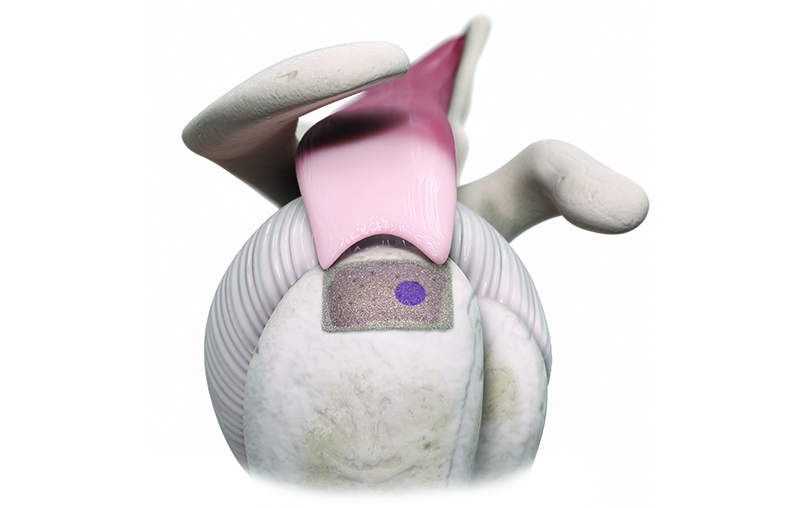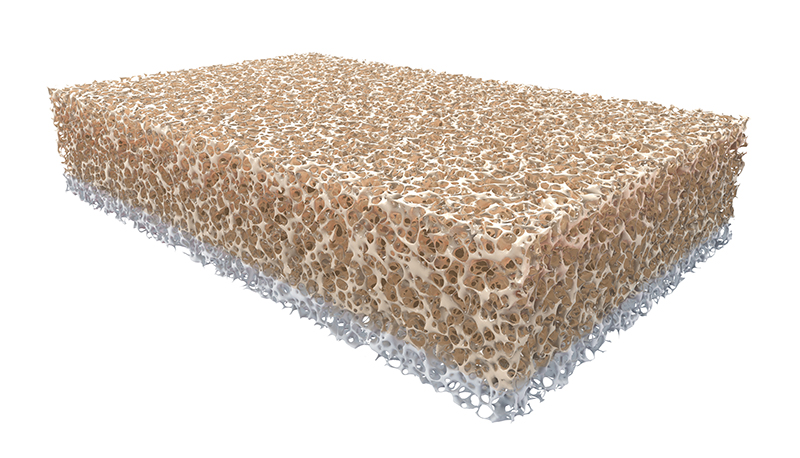March 31, 2021
This common shoulder injury could heal faster, thanks to the first implant that re-creates a crucial tissue structure
Longer-lasting rotator cuff repair may be possible with BioEnthesis, a Purdue University invention available on the market
WEST LAFAYETTE, Ind. — For sports fans, nothing beats seeing their favorite athletes compete at the top of their game. But a shoulder injury such as a badly torn rotator cuff threatens to pause or end the career of any athlete in sports ranging from football, basketball and baseball to golf and tennis.
Athletes sidelined with such an injury could benefit from a new tissue implant on the market invented at Purdue University. The implant has the potential to significantly speed up a patient’s recovery from rotator cuff surgery and offer a more robust repair that is less likely to retear.
The invention is the first implant that can re-create a tissue junction between the tendon and bone, called the enthesis. The ability to re-create the enthesis allows surgeons to more fully restore the natural structure of the joint in a way that hasn’t been possible before (YouTube video).
 A new implant on the market allows surgeons to re-create a tissue junction between the tendon and bone, called the enthesis, for the first time. (Credit: Sparta Biopharma)
Download image
A new implant on the market allows surgeons to re-create a tissue junction between the tendon and bone, called the enthesis, for the first time. (Credit: Sparta Biopharma)
Download image
In March, orthopedic sports medicine company Sparta Biopharma announced that it had brought the Purdue invention to market as BioEnthesis for rotator cuff repair. The first surgeries using BioEnthesis began in February at Rush University Medical Center in Chicago.
The implant could improve outcomes not only for professional athletes but also for people over the age of 60 who are most likely to experience more significant rotator cuff tears that may require surgery.
Recovering from a typical rotator cuff surgery often means weeks of pain and not being able to work or do any activity that involves using a shoulder to reach or pull. Repair for larger tears of the rotator cuff also could have a 50%-90% chance of retearing down the road.
Repairing bone in a part of the joint that couldn’t be repaired before
In a typical joint, tendon and bone meet at an enthesis that is only about a millimeter wide. Within that millimeter, hard, fibrous cartilage transitions into bone.
“The enthesis is an important part of the skeleton because it makes it possible to transmit the enormous forces generated by the muscles during daily activities. Every muscle in a person’s body attaches from tendon to bone through an enthesis,” said Eric Nauman, a Purdue professor of mechanical engineering and biomedical engineering.
 This first-of-its-kind implant has soft and hard tissue layers to facilitate the regrowth of bone in the enthesis of the rotator cuff, more fully restoring the natural structure of the joint. (Credit: Sparta Biopharma)
Download image
This first-of-its-kind implant has soft and hard tissue layers to facilitate the regrowth of bone in the enthesis of the rotator cuff, more fully restoring the natural structure of the joint. (Credit: Sparta Biopharma)
Download image
Without a way to re-create the enthesis, injuries requiring common surgeries such as rotator cuff repair have taken longer to heal. The bigger the size of the tear that needs to be repaired, the more likely it will retear after surgery. As early as age 30, the rotator cuff starts to weaken.
Since the enthesis is so fundamental to joint movement, BioEnthesis also has the potential to enhance healing for other parts of the body where the enthesis may be injured, such as the Achilles, patellar and quadriceps tendons, Nauman said.
BioEnthesis is a gum strip-sized, sponge-like scaffold made of real human tissue. The implant has two layers: a soft tissue layer to merge with the tendon and a hard tissue layer to allow a patient’s own stem cells to populate the implant from the bone marrow. The bone regrows within the implant to reform the enthesis, effectively repairing the joint.
The implant is compatible with arthroscopic surgery, a procedure typically used for rotator cuff repair.
“Though modern arthroscopic techniques have significantly improved outcomes following rotator cuff repair, there are still unacceptably high levels of retear. The mode of failure is typically related to the tendon not healing adequately to the bone through the enthesis," said Dr. Adam Yanke, chair of Sparta Biopharma’s scientific medical advisory board and an assistant professor at Midwest Orthopedics at Rush, who performed the first surgery using BioEnthesis. “Approaches to improving the tendon-to-bone healing such as scaffolds and biologics are likely to improve these structural failure rates.”
Sparta Biopharma plans to generate clinical data validating that BioEnthesis accelerates healing and improves retear rates for rotator cuff repair.
Inventing a way to rebuild where soft and hard tissue meet in the body
In 2004, Nauman and then-Purdue graduate student Darryl Dickerson met to discuss an unsolved challenge in tissue engineering: attaching tendon to bone.
“We had figured out how to re-create a major part of ligaments and tendons, but we didn’t have a good way to attach that soft tissue to the bone. Attachment to the bone is critical for the structure to be able to perform,” said Dickerson, who is now an assistant professor of mechanical and materials engineering at Florida International University.
Nine years later, Dickerson and Nauman published a paper demonstrating how a prototype of what is now BioEnthesis successfully reformed the enthesis in the rotator cuffs of animal models. The study showed that the approach allows the rotator cuff to heal itself over time.
The team began collaborating with Sparta Biopharma in 2018 to continue the development of the technology and bring it to market. Purdue Research Foundation’s Office of Technology Commercialization has numerous pending and issued patents covering the implant.
“It is incredible to see many years of research, design and development work translate into positive impact in people’s health and lives. The success of BioEnthesis for this very challenging orthopedic repair offers insight that will enable future clinical breakthroughs,” Dickerson said.
BioEnthesis is expected to be available in more surgery centers across the U.S. later this year.
About BioEnthesis
BioEnthesis is indicated to provide a matrix for the repair or reconstruction of the bone of the enthesis within the rotator cuff. It is a cancellous bone allograft and manufactured by an FDA-registered and AATB-accredited tissue bank that is compliant with Good Tissue Practices. More information.
About Sparta Biopharma Inc.
Sparta Biopharma is focused on researching, developing, and marketing novel osteobiologics in orthopedic sports medicine. Sparta's mission is to empower orthopedic surgeons with advancements that fundamentally restore movement for their patients. More information.
About Purdue University
Purdue University is a top public research institution developing practical solutions to today’s toughest challenges. Ranked the No. 5 Most Innovative University in the United States by U.S. News & World Report, Purdue delivers world-changing research and out-of-this-world discovery. Committed to hands-on and online, real-world learning, Purdue offers a transformative education to all. Committed to affordability and accessibility, Purdue has frozen tuition and most fees at 2012-13 levels, enabling more students than ever to graduate debt-free. See how Purdue never stops in the persistent pursuit of the next giant leap at https://purdue.edu/.
Writer, Purdue University media contact: Kayla Wiles, 765-494-2432, wiles5@purdue.edu
Sparta Biopharma media contact: Dimitrios Angelis, da@spartabio.com
Sources: Eric Nauman, enauman@purdue.edu
Darryl Dickerson, ddickers@fiu.edu
Journalists visiting campus: Journalists should follow Protect Purdue protocols and the following guidelines:
- Campus is open, but the number of people in spaces may be limited. We will be as accommodating as possible, but you may be asked to step out or report from another location.
- To enable access, particularly to campus buildings, we recommend you contact the Purdue News Service media contact listed on the release to let them know the nature of the visit and where you will be visiting. A News Service representative can facilitate safe access and may escort you on campus.
- Correctly wear face masks inside any campus building, and correctly wear face masks outdoors when social distancing of at least six feet is not possible.
Note to journalists: A video about the research is available on YouTube. Images of the implant and animated video showing the surgical procedure for using the implant to repair tears of the rotator cuff are available via Google Drive. Journalists visiting campus should follow visitor health guidelines.

